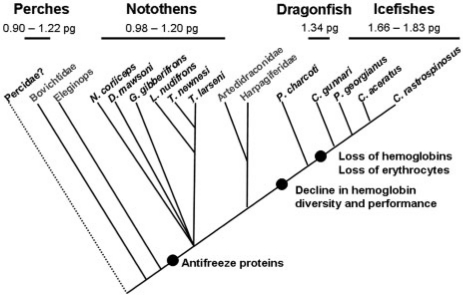Fig. 1.
Phylogenetic relationships among the 11 notothenioid species examined in this study. Six notothens of the basal, red-blooded family Nototheniidae (Dissostichus mawsoni, Gobionotothen gibberifrons, Lepidonotothen nudifrons, N. coriiceps, Trematomus larseni, and T. newnesi) and four icefishes of the white-blooded notothenioid crown group Channichthyidae (C. aceratus, Champsocephalus gunnari, Chionodraco rastrospinosus, and Pseudochaenichthys georgianus) are shown with the size ranges of their genomes. One species (Parachaenichthys charcoti) of the red-blooded dragonfishes (Bathydraconidae), the sister group to the icefishes, is also presented. The perches (Percidae) are the probable sister group to the Notothenioidei (Dettai and Lecointre 2004), and the size range of their genomes is based on Perca flavescens (Hinegardner and Rosen 1972; Hardie and Hebert 2004), P. fluviatilis (Vialli 1957; Vinograd 1998), and Sander lucioperca (Vinograd 1998). The positions of the notothenioid families Bovichtidae, Eleginops, Artedidraconidae, and Harpagiferidae (gray font; not examined herein) are shown for comparison. The closed circles indicate key evolutionary events during the diversification of the Notothenioidei: the acquisition of antifreeze proteins; the decline in hemoglobin multiplicity and performance; and the losses of hemoglobins and of red blood cells by the icefishes. The tree is based on the studies of Lecointre et al. (1997), Balushkin (2000), Near et al. (2004), and Near and Cheng (2008). Reproduced from Detrich et al. (2010). Copyright (2010 Wiley-Liss, Inc. a subsidiary of John Wiley & Sons, Inc.); Reprinted with permission of John Wiley & Sons, Inc.

